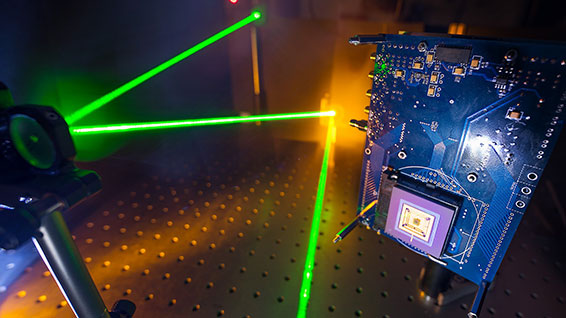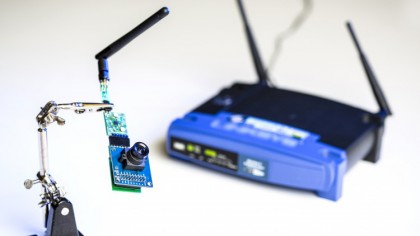These are the invisible cameras of the future

Hidden cameras are getting harder to spot: old, hefty spy gadgets you had to hide under a thick coat have been replaced tiny devices in the tips of pens that live stream HD video. Soon, thanks to new tech, spycams could even be entirely invisible.
But let's go back in time a little bit, to the era where spy gadgets were synonymous with Bond and U.N.C.L.E. Early hidden cameras were one of the coolest, and most ingenious, in their own right. The Stasi briefcase camera, used in the 1970s, boasted infrared film and a flash undetectable to the human eye, but it was so big you had to lug it around in – you guessed it – a briefcase. If anyone looked inside, you were busted.
Today's hidden cameras (sadly less kitsch, but exponentially more awesome) are more sophisticated – smaller, less obvious, and producing high quality images. Most are hidden in plain sight, concealed inside everyday objects, such as the aforementioned pen camera from Hammacher Schlemmer. There are lots of examples: you can buy cameras hidden inside of everything from water bottles to coat hooks.
But with all these cameras, you're able to spot them if you look closely enough.
Technology is about to change that. Researchers across the world are finding new ways to make cameras smaller; from lens-less cameras smaller than the point of a pencil, to cameras that can see around walls (yes, really), this is the cutting edge spy camera tech that's being worked on as we abseil our way through the 21st century - and we'll find out how likely it is to be scaring us by its presence (or lack thereof) in the near future.
Going miniature

Researchers are starting to remove the lenses from cameras in an attempt to go really tiny. American research company Rambus Labs is developing tiny lens-less image sensors that are just 200 micrometres thick – that's smaller than the point of a pencil.
The way this is made possible is by taking pictures a little differently. Normal digital cameras focus light onto a sensor, which breaks the image into millions of pixels and recreates them digitally.
Sign up for breaking news, reviews, opinion, top tech deals, and more.
The Rambus sensor has a microscopic grate in front of it, which causes the light to spiral into different patterns and hit the sensor from all angles. The image isn't recognisable at this point – it looks like a giant blur – but software can decode it into something visible.
The implications of such a tiny lens are obvious for spycams – the sensor is virtually undetectable to the human eye – and Rambus said it could potentially used for video in the future. The company is continuing to develop the sensors, and recently announced that they now have the ability to measure temperature, too. Watch this space – or try to, anyway.
Falling flat

Rambus aren't the only group going miniature by removing camera lenses. Rice University in Houston, Texas, have developed the FlatCam, a camera that's capable of producing 512 × 512 images – impressive, considering it's just half a millimetre thick.
It's a simple device: an image sensor underneath a grid covered in holes. Each hole allows different light to hit the sensor, and that information is then processed – using a desktop computer for now – into an image.
The researchers immediately realised the implications for security, commenting in their paper on the work in November 2015: "The thin form factor and low cost of lens-free cameras makes them ideally suited for many applications in surveillance".
Power out of thin air

Hidden cameras need power – and that often bulks them out. Batteries take up space, and power leads are hardly inconspicuous. Researchers from the University of Washington have come up with a solution: last year, they developed PoWiFi, a system powering a battery-free camera using just a Wi-Fi router in real homes (the Asus RT-AC68U).
They made a "harvester", which turns a normal 2.4 GHz Wi-Fi channel signal into power. It contains a rectifier that converts the WiFi into direct current (DC), and then a DC-DC converter which boosts the voltage, creating useful power.
To make sure the harvester receives a continuous Wi-Fi signal (and therefore power), the team created a transmitter that sent out extra "power traffic" from the router on each Wi-Fi channel, so the harvester detects continuous traffic – therefore always producing power.
It was high power enough that the camera sensor was able to take photos periodically every 35 minutes. There's a few catches – the camera only worked if it was within 17 feet of the router, and its images were black and white, 176 × 144. But it's a good start, and the team claims it "could integrate our camera with motion-detection sensors".
That's promising for hidden cameras in homes: multiple tiny cameras that never need the battery changing, activated by movement.
Flies instead of spies
Ever heard of MAVs? Micro air vehicles (to you and me) are small drones used in the military as spycams – the British army use the Black Hornet to scout ahead in the field without being seen. Developing this kind of undetectable tech is big business.
The University of Southampton, for example, are testing MAVs that have membranous, flapping wings, based on bat physiology. They're more aerodynamic, more economical to run, and can travel longer distances. It's the kind of technology that could make its way to the consumer market sharpish.
There's an effort to make MAVs smaller too: Harvard researchers have created a flying robot with a wing span of 3cm. They haven't been tested with cameras yet, but it's not hard to imagine combining MAVs drones with tiny cameras to produce spycams that you could easily mistake for a buzzing fly.
We're already seeing drone manufacturers sizing down their products: Axis recently released a drone that can fit in the palm of your hand, and records video at 420p, as the trend downwards in size continues.
Going round the bend

In the absence of spy glasses that let you see through walls, researchers at Heriot-Watt University and the University of Edinburgh have come up with the next best thing: a camera that can see around walls.
The device sends a laser pulse at the floor near the corner it is trying to "see" around. The laser scatters in all directions, and some of it bounces off an object – in the experiment the team conducted, a moving toy truck crashing into a small figurine, producing an "echo".
That reflected light is then picked up by a camera, a single-pixel avalanche diode array (SPAD). It's very sensitive – it can detect a single photon of light, and record the reflected light coming back at 20 billion frames per seconds in its field of vision.
Every object in a room produces an echo – the walls, the laser emitter, etc – but the camera can distinguish the specific echo of any moving object because that is always changing, where the others are static.
By measuring the time it takes between laser pulse and the echo reaching the camera, as well as the shape of the echo, the team are able to track moving objects in real time.
It's rudimentary for now – the moving object has to be close to the corner, and there's no way of reconstructing the image in 3D yet. But the team are working on it, and obviously recognise that the technology could have a role in surveillance.
Using tiny pixels to improve image quality
If we want tiny cameras, the assumption is we're going to have to put up with lower image quality, right?
Maybe not. With the help of a new type of pixel, researchers at Dartmouth College are making tiny small cameras that shoot sharp pictures.
Headed by Eric Fossum – the inventor of the CMOS sensor, used in practically all smartphones and cameras – the team at the Thayer School of Engineering are building a new type of image sensor that can perform especially well in low-light conditions, called Quanta Image Sensor (QIS).
They're using a new type of ultra-small pixel, called a jot. Jots are so small that they can each sense a single photon of light – and you can have 1 billion of them on the QIS.
So how does this improve image quality? Well, when a photon hits an image sensor, it undergoes a chemical reaction, and releases an electron. The jots on the QIS are so sensitive that they're able to sense these single electrons – and that has huge implications for imaging where there's not much light around.
While this research won't make cameras smaller, it will make small cameras better. It's still a "proof of concept" but, according to the researchers, the aim is to get this tech out to consumers, so we won't have to imagine tiny spy cameras that can get quality images in the dark - they'll be real life devices if the research continues.
So are we on the edge of a spycam revolution?
Research that makes cameras smaller will be "evolutionary", rather than revolutionary, according to Dr Roelof van Silfhout, lecturer in Embedded Vision Systems at Manchester University.
Eric Fossum's research on tiny pixels is a good example of this – it's conceptual (with great potential) but it's not going to be appearing online to buy any time soon.
In some similar research, one of Dr van Silfhout's colleagues is looking at making pixels "more intelligent" by giving each pixel its own processor. That doesn't add to the size of a camera, he says, because you can stack them up in a grid lying directly under a flat sensor.
The other form of "hidden" cameras – when they're obscured around a corner – is a very "peculiar" way of doing things, van Silfhout says. While the research with laser cameras at the University of Edinburgh "raised an eyebrow" in the academic world, it won't translate to the real world for a good while.
"I don't expect that you'll have a camera very soon that will take detailed images of what is around the corner in the way that the research is hinting. The signals that they collect are really weak," he says.
So how far are we away from a hidden camera breakthrough? Dr van Silhout expects lensless cameras to lead the way. What will determine their success, he says, is how these cameras are used: breakthroughs will come through the method of imaging, not the hardware, he predicts.
"It's a continuous effort. I don't all of a sudden [think]we'll have a camera that's ten times smaller. What we will have [are] new ways of looking at things, 3D, stereoscopic imaging, and a lot of it will be driven by applications," he says.